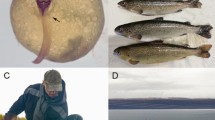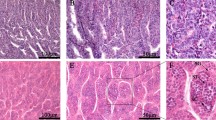Abstract
This study used tiger puffer Takifugu rubripes to explore new, simple methods for low-temperature-induced masculinization in a cultured fish without the use of ultraviolet irradiation or sex hormones. An orthogonal test L9(34) design was used to consider three factors at three levels: treatment starting times (days post-hatch, dph: factor A) of 20, 50 and 80 dph; treatment temperatures (factor B) of 13°C, 15°C and 17°C; and treatment durations (factor C) of 30, 45 and 60 days. A control group was reared at 21±1°C. The experiments were repeated twice. At 230 dph, the gonads were removed from thirty randomly sampled fish in each group. Histological observations and analysis of single nucleotide polymorphisms (SNP) were used to identified pseudo males, which biological sex was male and genetic sex were female (XX). Treatment group 4 (A2B1C2) resulted in the highest proportion of males (75%). According to the intuitive analysis of the orthogonal-array experiments, the optimal combination of low-temperature-induced masculinization of T. rubripes was A2B1C2. The population sex ratio depended on the three factors in the sequence B→A→C. A comparison of the daily increases in length and weight during and after the low-temperature conditions showed that the absolute daily increases in weight and length were significantly less during treatment than after treatment. Daily increases in weight and length did not significantly differ between the treatment groups and the controls (P>0.05), demonstrating that the growth rate could return to normal after the low-temperature conditions. This study establishes a low-temperature-induced masculinization technology for T. rubripes and demonstrates that although the growth rate (length and weight) decreased in an array of nine treatment groups during the processing time, it returned to a normal level after processing. The results should serve as a guide for achieving the masculinization of T. rubripes in production.
Similar content being viewed by others
References
Baroiller J-F, D’Cotta H. 2016. The reversible sex of gonochoristic fish: insights and consequences. Sex Development, 10(5–6): 242–266.
Cheng X C, Lin D J, You Y L. 2007. Influence of temperature on sex differentiation of teleost, Pseudobagrus vachelli. Zoological Research, 28(1): 73–80. (in Chinese with English abstract)
Conover D O, Kynard B E. 1981. Environmental sex determination: interaction of temperature and genotype in a fish. Science, 213(4507): 577–579.
Conover D O. 2004. Temperature-dependent sex determination in fishes. In: Temperature-Dependent Sex Determination in Vertebrates. Smithsonian Books, Washington. p.11–20.
Craig J K, Foote C J, Wood C C. 1996. Evidence for temperature-dependent sex determination in sockeye salmon (Oncorhynchus nerka). Canadian Journal of Fisheries and Aquatic Sciences, 53(1): 141–147.
Devlin R H, Nagahama Y. 2002. Sex determination and sex differentiation in fish: an overview of genetic, physiological, and environmental influences. Aquaculture, 208(3–4): 191–364.
Ewert M A, Nelson C E. 1991. Sex determination in turtles: diverse patterns and some possible adaptive values. Copeia, 1991(1): 50–69.
Fernandino J I, Hattori R S, Kishii A, Strüssmann C A, Somoza G M. 2012. The cortisol and androgen pathways crosstalk in high temperature-induced masculinization: the 11β-hydroxysteroid dehydrogenase as a key enzyme. Endocrinology, 153(12): 6 003–6 011.
Fernandino J I, Hattori R S, Moreno Acosta O D, Strüssmann C A, Somoza G M. 2013. Environmental stress-induced testis differentiation: androgen as a by-product of cortisol inactivation. General and Comparative Endocrinology, 192: 36–44.
Gui J F. 2007. Genetic Basis and Artificial Control of Sexually and Reproduction in Fish. Science Press, China, p.62. (in Chinese)
Hattori N, Miyashita S, Sawada Y. 2012. Effective masculinization method of tiger puffer by temperature control under culture condition. Journal of the Japan Fisheries Society, 78(1): 87. (in Japanese)
Hattori R S, Fernandino J I, Kishii A, Kimura H, Kinno T, Oura M, Somoza G M, Yokota M, Strüssmann C A, Watanabe S. 2009. Cortisol-induced masculinization: does thermal stress affect gonadal fate in pejerrey, a teleost fish with temperature-dependent sex determination? PLoS One, 4(8): e6548.
Jiang Z Q, Wu L X, Hao L D, Bai L J, Feng Z X. 2005. Mariculture Fish Biology and Aquaculture. Ocean Press, Beijing, China. p.61. (in Chinese)
Kamiya T, Kai W, Tasumi S, Oka A, Matsunaga T, Mizuno N, Fujita M, Suetake H, Suzuki S, Hosoya S, Tohari S, Brenner S, Miyadai T, Venkatesh B, Suzuki Y, Kikuchi K. 2012. A trans-species missense SNP in Amhr2 is associated with sex determination in the tiger pufferfish, Takifugu rubripes (Fugu). PLoS Genetics, 8(7): e1002798.
Kikuchi K, Kai W, Hosokawa A, Mizuno N, Suetake H, Asahina K, Suzuki Y. 2007. The sex-determining locus in the tiger pufferfish, Takifugu rubripes. Genetics, 175(4): 2 039–2 042.
Kitano T, Hayashi Y, Shiraishi E, Kamei Y. 2012. Estrogen rescues masculinization of genetically female medaka by exposure to cortisol or high temperature. Molecular Reproduction and Development, 79(10): 719–726.
Lee K H, Yamaguchi A, Rashid H, Kadomura K, Yasumoto S, Matsuyama M. 2009. Germ cell degeneration in high-temperature treated pufferfish, Takifugu rubripes. Sexual Development, 3(4): 225–232.
Lei J L. 2005. Marine Fish Culture Theory and Techniques. China Agriculture Press, Beijing, China. p.683–702. (in Chinese)
Li Y Q, Fu Z. 1993. The effect of different temperature on the growth and survival of larvals and juveniles in Takifugu rubripes. Hebei Yuye, (2): 26–27. (in Chinese)
Liu Y X, Zhou Q, Zhang H T, Jiang C B, Zhang F C. 2014. Effect of temperature on growth and sex differentiation at early developmental stage of redfin puffer (Takifugu rubripes). South China Fisheries Science, 10(5): 24–29. (in Chinese with English abstract)
Luckenbach J A, Borski R J, Daniels H V, Godwin J. 2009. Sex determination in flatfishes: Mechanisms and environmental influences. Seminars in Cell & Developmental Biology, 20(3): 256–263.
Luckenbach J A, Godwin J, Daniels H V, Borski R J. 2003. Gonadal differentiation and effects of temperature on sex determination in southern flounder (Paralichthys lethostigma). Aquaculture, 216(1–4): 315–327.
Ma A J, Lu L J, Chen C, Wang X A, Meng X S, Li W Y, Liu S C. 2011. Breeding and genetic research of major economic species of Fugu. Marine Sciences, 35(11): 128–133. (in Chinese)
Matsuura S, Naito T, Shincho M, Yoshimura K, Matsuyama M. 1994. Gonadal sex differentiation in tiger puffer, Takifgu rubripes. Aquaculture Science (Japan), 42(4): 619–625.
Nan P, Du Q Y, Yan S G, Chang Z J. 2005. Effects of temperature on sex differentiation of gonads and the cloning and expression of CYP19a in two species of loaches. Journal of Fishery Sciences of China, 12(4): 407–413. (in Chinese with English abstract)
Ospina-Álvarez N, Piferrer F. 2008. Temperature-dependent sex determination in fish revisited: prevalence, a single sex ratio response pattern, and possible effects of climate change. PLoS One, 3(7): e2837.
Pan C Y, He Y H. 1993. Mathematical Statistics Theory and Method. Tongji University Press, Shanghai, China. p.292–293. (in Chinese)
Person-Le Ruyet J, Mahé K, Le Bayon N, Le Delliou H. 2004. Effects of temperature on growth and metabolism in a Mediterranean population of European sea bass, Dicentrarchus labrax. Aquaculture, 237(1–4): 269–280.
Sahi T. 2001. Effect of water temperature on growth of hatchery reared Black Sea Turbot, Scophthalmus maximus (Linnaeus, 1758). Turkish Journal of Zoology, 25(3): 183–186.
Suzuki N, Okada K, Kamiya N. 1996. Gonadal development, sexual differentiation and sex ratio of tiger puffer, Takifugu rubripes. Bulletin of the National Fisheries Research Institute (Japan), 29(2): 39–48.
Suzuki Y. 2010. According to the genetic breeding of new varieties tiger puffer varieties as the goal. Biological Function Development Research Institute (Japan), 10: 9–23. (in Japanese)
Tian B J, Li Y W, Ding Q, Geng L N. 2007. A comparison of rotifer and brine shrimp in nutrient value. Hebei Fisheries, (12): 45–47. (in Chinese)
Tian Y S, Wang D, Xu Y, Chen S L. 2011. Effects of rearing temperature on growth and sex determination in the half-smooth tongue sole (Cynoglossus semilaevis). Journal of Fisheries of China, 35(2): 176–182. (in Chinese with English abstract)
Yamaguchi T, Kitano T. 2012. High temperature induces cyp26b1 mRNA expression and delays meiotic initiation of germ cells by increasing cortisol levels during gonadal sex differentiation in Japanese flounder. Biochemical and Biophysical Research Communications, 419(2): 287–292.
Yamaguchi T, Yoshinaga N, Yazawa T, Gen K, Kitano T. 2010. Cortisol is involved in temperature-dependent sex determination in the Japanese flounder. Endocrinology, 151(8): 3 900–3 908.
Yamamoto E. 1999. Studies on sex-manipulation and production of cloned populations in hirame, Paralichthys olivaceus (Temminck et Schlegel). Aquaculture, 173(1–4): 235–246.
Yamamoto Y, Zhang Y, Sarida M, Hattori R S, Strüssmann C A. 2014. Coexistence of genotypic and temperature-dependent sex determination in pejerrey Odontesthes bonariensis. PLoS One, 9(7): e102574.
Yang J, Wu H D, Fan Z T. 2007. Advances on sex determination mechanism of fish. Fisheries Economy Research, (3): 14–19. (in Chinese with English abstract)
Zhou H, Li J Q, Ma H Y, Li Y J, Jiang Z Q, Li X, Xu W, Jiang Z H. 2015. Low temperature-induced masculinization and histological observation of gonadal differentiation in redfin puffer Takifugu rubripes. Journal of Dalian Fisheries University, 30(1): 41–47. (in Chinese with English abstract)
Author information
Authors and Affiliations
Corresponding author
Additional information
Supported by the National Natural Science Foundation of China (No. 41606178), the Liaoning Department of Education Key Laboratory of Basic Research Project (No. LZ2015010), and the Liaoning Doctor Scientific Research Foundation Project (No.201501185)
Rights and permissions
About this article
Cite this article
Zhou, H., Zhuang, Z., Zhang, R. et al. Temperature-control-induced masculinization in tiger puffer Takifugu rubripes. J. Ocean. Limnol. 37, 1125–1135 (2019). https://doi.org/10.1007/s00343-019-7382-z
Received:
Accepted:
Published:
Issue Date:
DOI: https://doi.org/10.1007/s00343-019-7382-z




